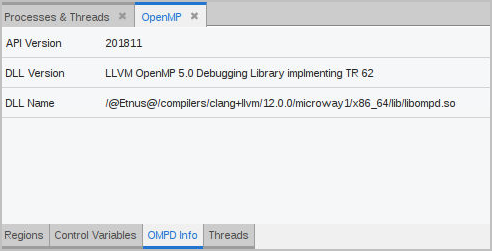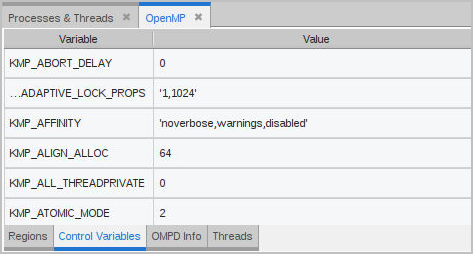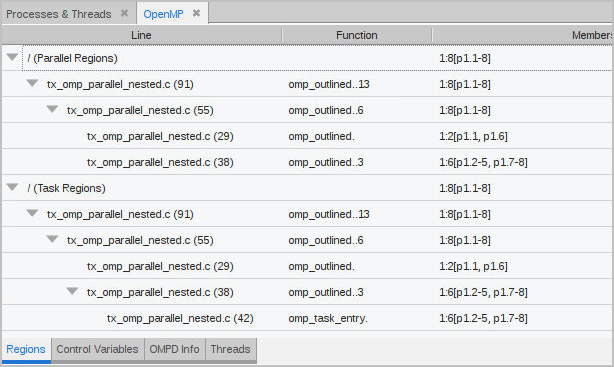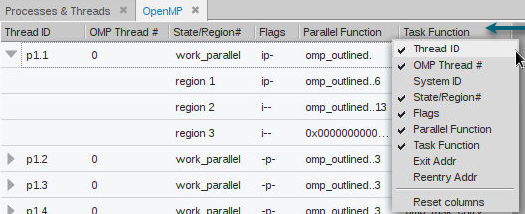The OpenMP View
The OpenMP view displays all the OMPD information provided by the OpenMP Debugging Interface, also available via the domp CLI command.
Information about the OMPD dynamic library (DLL) in use for the selected process. 

CLI command: domp -ompd
The OMPD display control variable settings for a selected process. Changing the focus to a different process repopulates this list with that process’s control variables. 

CLI command: domp -control_vars
The internal control variables that maintain runtime state. 

The ICV name is canonicalized and uniquified based on the ICV map extracted from the OMPD library. Any OMP 5.0 OMPD-specific ICV names, which all begin with ompd-, are either renamed to their OMP 5.2 name or discarded if the OMP 5.2 name is also defined.
CLI command: domp -icvs
The nest of parallel and task regions for the entire share group of the selected process. Selecting different regions in the display focuses the source pane on the specific region.

CLI Command: domp -threads -regions
Displays details on all the OpenMP threads in the application. 

Note that:
Expand any top level thread to display the thread’s nest of parallel and task regions.
In the example above, Thread 1.2’s region 1 has a parent of 1.1, which created the region being executed.

This setting is persisted between sessions.
CLI Command: domp -threads. This command has numerous options that are all included as columns within this Threads tab.
Column | Description |
|---|---|
Thread ID | The TotalView process and thread id or the MPI Rank and thread ID if this is an MPI program. |
OMP Thread # | The thread’s OpenMP thread number within its current team. |
System ID | The thread’s Kernel ID or user thread id. |
State/Region # | The thread’s OpenMP state for the top-level thread. This state is defined by the OpenMP standard. If the expander on the top-level thread is clicked, the thread’s nest of parallel or task regions is displayed, and the column shows the index of the region. |
Wait Id/Parent | The thread's OpenMP current wait ID or Parent ID. The Parent ID (which includes the debugger process and thread ID) is the ID of the encountering thread for the region. |
Flags | OpenMP Flags. The following flags are reported: When true, the flag is displayed by just its letter. If false, the flag is displayed as a hyphen (“-”). If the flag could not be fetched, a “?” is displayed. |
Task Function | The subroutine name for the task function for the implicit or explicit task region. If the task function cannot be determined, "<unavailable>" is displayed. |
Task Line | The file name and line number of the task function. |
Exit Addr | The thread’s stack address corresponding to the location where control exited the OpenMP runtime to execute the task user code. The exit address is 0 for the root region. |
Reentry Addr | The thread’s stack address corresponding to the location where control reentered the runtime from the user task code. The reentry address is 0 for a leaf. |





